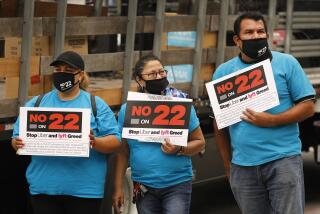Lane changes and the law
- Share via
It should be a simple question for any driver: Is it legal to change your mind about making a turn after you’ve entered a turn lane? But getting to the truth is pretty complicated.
Most of the time when a driver gets a ticket for an alleged violation, the only question is whether he or she is guilty of committing it. A more basic issue is whether the act in question is even illegal under the California Motor Vehicle Code.
Very few motorists ever read the actual code, perhaps for good reason. It is admittedly less complex than the U.S. Tax Code, but full of the same kind of incomprehensible language and trapdoor logic that only an attorney could fully appreciate.
And more than that, the police should not be handing out tickets to people who drive in a safe and careful manner, but violate complex rules of vehicle code sections not even mentioned in the California Drivers Handbook.
Take, for example, the case of Nick Gulati, who wrote to me last year about getting a ticket after entering a left-turn pocket at an intersection and then changing his mind after the light turned green. He merged safely back into the traffic lanes to the right and then promptly received a ticket.
When he wrote to me, he said he merely crossed a solid white line separating the turn pocket from other lanes and, of course, it is perfectly legal to cross a solid white line.
I took his question to the California Highway Patrol, where a vehicle code expert said the officer was correct in issuing a ticket, because the code prohibits drivers from changing out of the turn lane once they enter an intersection.
It is not clear whether Gulati actually exited the turn lane before crossing the limit line that defines the intersection, though that is certainly possible. Either way, the vehicle code seems to lack clarity on such situations.
After writing about Gulati’s case, I heard an outcry from a few readers who said the vehicle code says no such thing as “drivers may not change their minds” about turns after entering a dedicated turn lane.
Indeed, Eric Blum, an Orange County attorney who sits as a pro-tem judge in traffic court, says the CHP incorrectly interpreted the vehicle code and that nothing in it specifically outlaws what Gulati apparently did.
“I think tickets are often a nuance issue, and even police officers who write them are not always aware of the exact language of the statutes,” Blum says. “I had this exact issue come before me several months ago and ... I found [the driver] not guilty.” In this case, the driver was cited under code section 21453c. Here’s a taste of the code:
“A driver facing a steady red arrow signal shall not enter the intersection to make a movement indicated by the arrow and unless entering the intersection to make a movement permitted by another signal, shall stop at a clearly marked limit line, but if none, before entering the crosswalk on the near side of the intersection or, if none, then before entering the intersection, and shall remain stopped until an indication permitting movement is shown.”
I don’t see anything in this wretched sentence that says, “A driver can’t change his or her mind about making a turn after entering a dedicated turn lane.” And neither did Blum.
“The CHP’s reasoning is not supported by the language of the statute,” Blum says.
When I contacted the CHP, however, the officers continued to insist that they interpret the code as prohibiting a driver from changing lanes inside the intersection.
Blum says, however, intersections generally have no lane lines inside them, so it cannot possibly be illegal to change lanes when they don’t exist.
Another section of the code cited by the CHP, 21451b, seems closer to the mark. It says: “A driver facing a green arrow signal, shown alone or in combination with another indication, shall enter the intersection only to make the movement indicated by that green arrow or any other movement that is permitted by other indications shown at the same time.”
Let’s get back to Gulati. I contacted him to see whether he was charged under the same code section as the Blum case or a different one. But he could not recall. Since his infraction involved a left-turn lane, it was probably charged under a different section.
“I already went to traffic school to clear that ticket for my record anyway,” he told me. The whole miserable affair was ancient history for Gulati.
Other readers contacted me to say that changing your mind at turn lanes should be illegal. Mark Evans wrote to say that he often sees drivers using turn lanes to pass backed-up cars at an intersection and then cut back in. I agree, but I think the vehicle code needs to be clear on the issue.
The other lesson here is that any time you get a ticket, you should closely examine the code section you are charged with violating and make sure it clearly addresses what you were doing. You can find the code at www.dmv.ca.gov. Get a cup of strong coffee and go to the publications section of the website.
“Don’t believe what the police tell you even though they have a lot of experience,” Blum says. “Look it up for yourself.”
Ralph Vartabedian can be reached at ralph.vartabedian @latimes.com.







